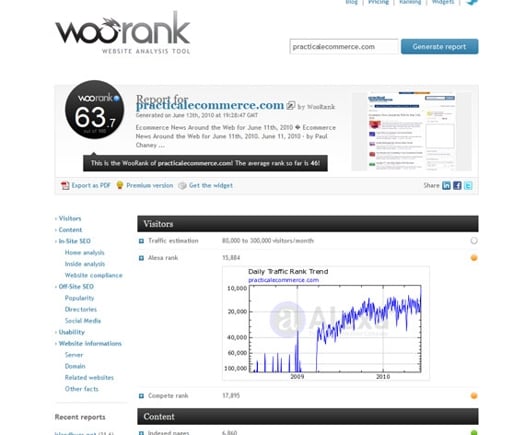Search engine optimization (SEO) is changing. As search engines like Google, Bing, and Ask seek to provide better, more relevant, personalized, and, perhaps, even real-time results to search queries, so-called traditional SEO tactics may not work as expected.
What’s more, since search engines seek to provide good, human-usable query results and avoid being tricked by cleaver titles, header tags, or even link sculpting, every site administrator should seek first to provide excellent, accessible, and usable content for humans. Only after good content is addressed, should we look to provide structure or meta data aimed at search engines and thereby improve site visibility.
In this new era of SEO, site owners need more and better data about how a site is ranking and performing.
WooRank is a new, free service that lets site administrators monitor both SEO and human-usable aspects of their sites by aggregating analysis data from several existing tools, including Alexa, Google, and Traffic Travis, along with some other insights that WooRank generates itself. For providing a good sampling of site data in one location, I am awarding WooRank three and a half out of a possible five stars in this “The PEC Review.”
“The PEC Review” is my weekly column created solely to introduce you to products or services that I believe will help you improve your ecommerce business. This week, let me encourage you to check out WooRank.

Visitor Data and Ranking
WooRank begins its analysis of a site by estimating site traffic, getting a site’s Alexa ranking, and ranking a site’s traffic estimates against other sites from the same region.
While you will almost certainly be able to get better traffic data about your own site from Google Analytics, Omniture, or similar site traffic monitoring tools, WooRank lets you compare your site against average results from other sites, to help you identify where you are in the spectrum of sites from your region.
What’s more, WooRank is not limited to your own site. You can easily generate reports for your competitor’s sites and compare their results with your own point by point.
Content
The services also captures a couple of interesting tidbits about your site’s content, including how many pages are index and what your most popular pages are. Again, you can also capture similar data for your competitive set.
SEO and Standards Compliance
Finally, the bulk of the WooRank report focuses on SEO and web standard compliance. For example, WooRank counts header tags, monitors titles, counts images, and notes whether or not you have a robots.txt file to help search engines.
In all, there are 33 SEO and compliance-related data points that can be used to help you monitor your business. As an example, WooRank monitors Twitter and Digg backlinks—to some extent—so that you could use the report to help monitor the success of social marketing campaigns aimed at generating more inbound links from these sites.
Price
As mentioned above, WooRank is a free service. The company does have plans to launch a premium service that site owners might subscribe to, but when that premium service will be available is not yet known.
Minor Bits of Misinformation
I do need to mention a couple of minor points where WooRank could be a little misleading.
First, in its SEO section WooRank monitors text-to-HTML ratios and then suggests to users that “higher ratios boost SEO by increasing keyword density.”
This is wrong for at least two reasons. First, text-to-HTML ratios do not necessarily reflect keyword densities. And second, keyword density strategies are in no way helpful for SEO. Stuffing your copy with keywords is a really bad idea, and I personally distrust any alleged professional that suggests it. But don’t just take my word for it. You can read, as a starter, “The Keyword Density of Non-Sense” report, which explains why this is not an effective SEO tactic in some detail.

Next, WooRank’s backlinks for Twitter and Digg seemed to not include shortened URLs that ultimately resolved to the domain in view. As an example, WooRank reported 58 Twitter links for Practical Ecommerce, a manual count of my own Twitter feed shows that I had personally linked to Practical Ecommerce about 20 times in June 2010 alone. But I always used bit.ly addresses, which may be why WooRanks seemingly missed them.
Finally, if your site has any Flash on it at all, WooRank gives you a “red” light indicating that this is somehow damaging your SEO, which is an extreme over simplification.
Summing Up
WooRank is an excellent source of data about your site and about the sites you compete with. It provides dozens of data points that you can use to monitor your marketing or streamline your content and SEO.
Personally, I would simply use the data WooRank offers, along with my own insights and experience, to improve my site and ignore suggestions about keywords or Flash. Overall, WooRank earns the three and a half out of the possible five stars that I awarded it in this review. I would also strongly encourage you to try WooRank right now.




